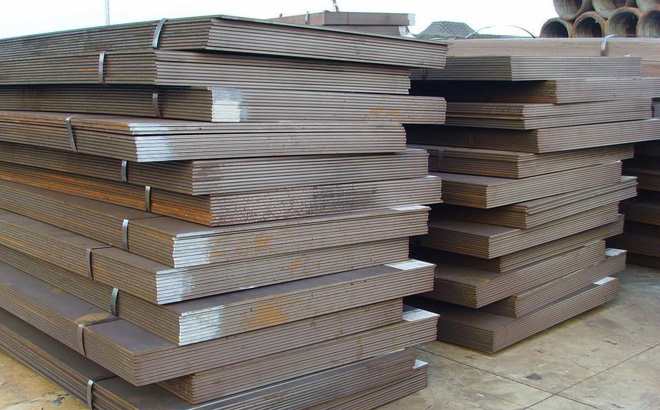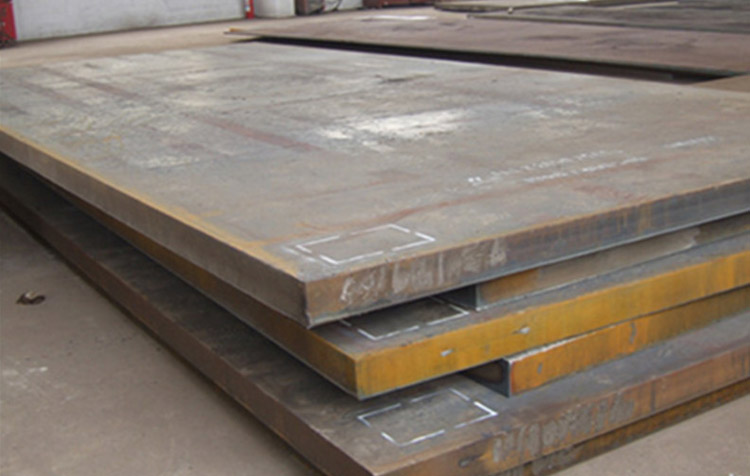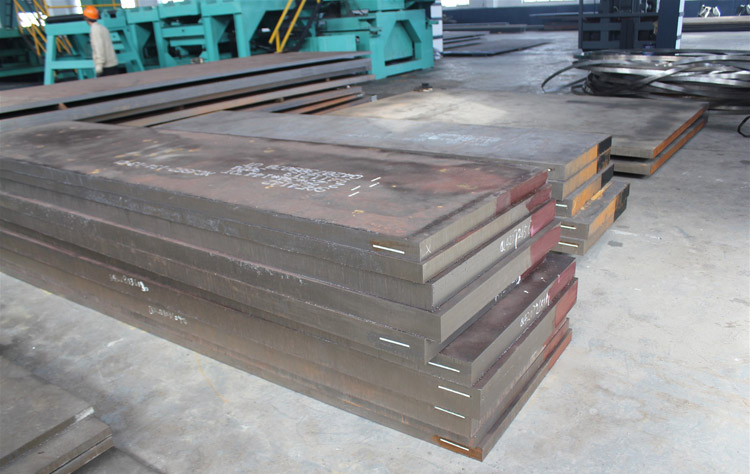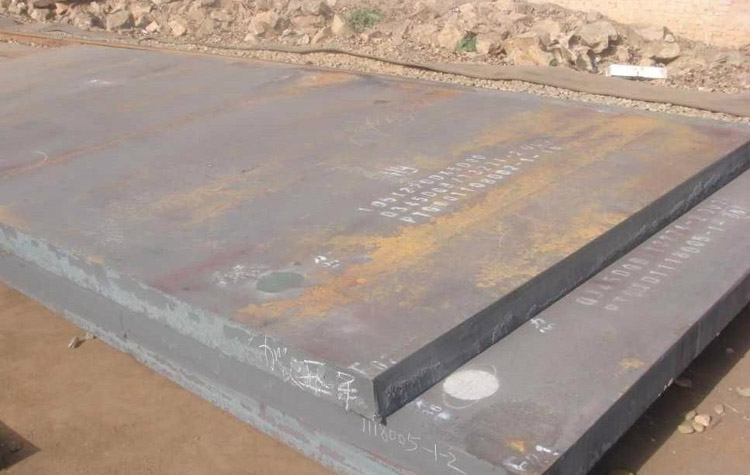abrasion resistant steel plate
Abrasion Resistant Steel Plate
Wear Steel Standards:
-
NM360, NM400, NM450, NM500
-
NR360, NR400
-
B-HARD360, B-HARD400, B-HARD450
-
KN-55, KN-60, KN-63
-
AR400, AR450, AR500, AR600
Wear/Abrasion Resistant Steel Equivalent Standards
|
Steel Grade |
SSAB |
JFE |
DILLIDUR |
ThyssenkKrupp |
Ruukki |
|
NM360 |
- |
EH360 |
- |
- |
- |
|
NM400 |
HARDOX400 |
EH400 |
400V |
XAR400 |
Raex400 |
|
NM450 |
HARDOX450 |
- |
450V |
XAR450 |
Raex450 |
|
NM500 |
HARDOX500 |
EH500 |
500V |
XAR500 |
Raex500 |
Wear/Abrasion Resistant Steel --- Chinese Standard
Chemical Composition (%) of NM Wear Resistant Steel
|
Steel Grade |
C |
Si |
Mn |
P |
S |
Cr |
Mo |
B |
N |
H |
Ceq |
|
NM360/NM400 |
≤0.20 |
≤0.40 |
≤1.50 |
≤0.012 |
≤0.005 |
≤0.35 |
≤0.30 |
≤0.002 |
≤0.005 |
≤0.00025 |
≤0.53 |
|
NM450 |
≤0.22 |
≤0.60 |
≤1.50 |
≤0.012 |
≤0.005 |
≤0.80 |
≤0.30 |
≤0.002 |
≤0.005 |
≤0.00025 |
≤0.62 |
|
NM500 |
≤0.30 |
≤0.60 |
≤1.00 |
≤0.012 |
≤0.002 |
≤1.00 |
≤0.30 |
≤0.002 |
≤0.005 |
≤0.0002 |
≤0.65 |
|
NM550 |
≤0.35 |
≤0.40 |
≤1.20 |
≤0.010 |
≤0.002 |
≤1.00 |
≤0.30 |
≤0.002 |
≤0.0045 |
≤0.0002 |
≤0.72 |
Mechanical Properties of NM Wear Resistant Steel
|
Steel Grade |
Yield Strength /MPa |
Tensile Strength /MPa |
Elongation A50 /% |
Hardess (Brinell) HBW10/3000 |
Impact/J (-20℃) |
|
NM360 |
≥900 |
≥1050 |
≥12 |
320-390 |
≥21 |
|
NM400 |
≥950 |
≥1200 |
≥12 |
380-430 |
≥21 |
|
NM450 |
≥1050 |
≥1250 |
≥7 |
420-480 |
≥21 |
|
NM500 |
≥1100 |
≥1350 |
≥6 |
≥470 |
≥17 |
|
NM550 |
- |
- |
- |
≥530 |
- |
Wear/Abrasion Resistant Steel --- USA Standard
Abrasion Resistant Steel Plate Availabillity
|
Grade |
Thickness |
Width |
Length |
|
AR200 / AR 235 |
3/16" – 3/4" |
48" – 120" |
96" – 480" |
|
AR400F |
3/16" – 4" |
48" – 120" |
96" – 480" |
|
AR450F |
3/16" – 2 " |
48" – 96 " |
96" – 480" |
|
AR500 |
3/16" – 2 " |
48" – 96 " |
96" – 480" |
|
AR600 |
3/16" – 3/4" |
48" – 96 " |
96" – 480" |
Chemical Composition of Abrasion Resistant Steel Plate
|
Grade |
C |
Si |
Mn |
P |
S |
Cr |
Ni |
Mo |
B |
|
AR500 |
0.30 |
0.7 |
1.70 |
0.025 |
0.015 |
1.00 |
0.70 |
0.50 |
0.005 |
|
AR450 |
0.26 |
0.7 |
1.70 |
0.025 |
0.015 |
1.00 |
0.70 |
0.50 |
0.005 |
|
AR400 |
0.25 |
0.7 |
1.70 |
0.025 |
0.015 |
1.50 |
0.70 |
0.50 |
0.005 |
|
AR300 |
0.18 |
0.7 |
1.70 |
0.025 |
0.015 |
1.50 |
0.40 |
0.50 |
0.005 |
Mechanical Properties of Abrasion Resistant Steel Plate
|
Grade |
Yield Strength MPa |
Tensile Strength MPa |
Elongation A |
Impact Strength Charpy V 20J |
Hardness Range |
|
AR500 |
1250 |
1450 |
8 |
-30C |
450-540 |
|
AR450 |
1200 |
1450 |
8 |
-40C |
420-500 |
|
AR400 |
1000 |
1250 |
10 |
-40C |
360-480 |
|
AR300 |
900 |
1000 |
11 |
-40C |
- |
Abrasion Resistant Steel Plate Applications:
-
The AR235 plates are intended for moderate wear applications where it offers improved wear resistance relative to structural carbon steel.
-
The AR400 are premium abrasion resistant steel plates that are heat-treated and exhibit through-hardening. Improved forming and weding capabilities.
-
AR450 is an abrasion resistant plate used in a variety of applications where slightly greater strength is desired beyond AR400.
-
AR500 plates are suitable for mining, forestry and construction applications.
-
AR600 is utilized in high-wear areas such as aggregate removal, mining, and the manufacture of buckets and wear bodies.
Abrasion Resistant (AR) steel plate is typically made in the as-rolled condition. These types/grades of steel plate products have been developed specifically for long service life in harsh conditions. AR products are suitable for a variety of applications in areas such as mining/quarrying, conveyors, material handling and construction, and earthmoving. Designers and plant operators choose AR plate steel when striving to extend service life of critical components, and reduce the weight of each unit put into service. The benefits of employing wear-resistant plate steel in applications involving impact and/or sliding contact with abrasive material are immense.
Abrasive resistant alloy steel plates generally offer good resistance to sliding and impact abrasion. The high carbon content in the alloy increases the hardness and toughness of the steel, making it an ideal material for applications that require high impact or high abrasion resistance. It is possible to get high hardness with a high carbon steel, and the steel will have good resistance to penetration. However, the wear rate will be rapid compared to heat treated alloy plate because high carbon steel is brittle, so particles can be more easily torn from the surface. As a result, high carbon steels are not used for high wear applications.
Get In touch with







